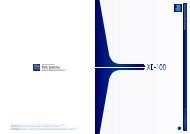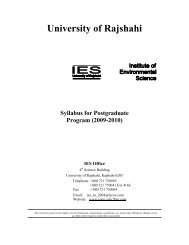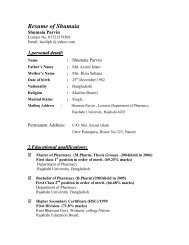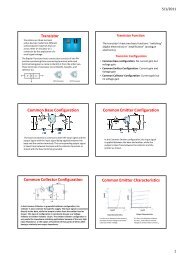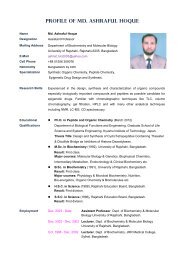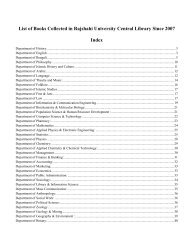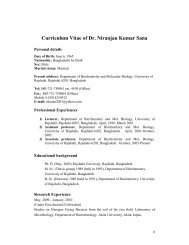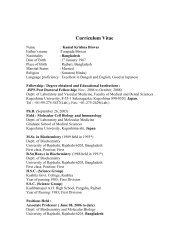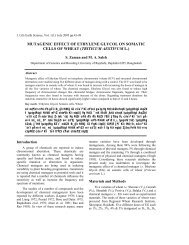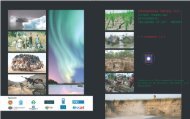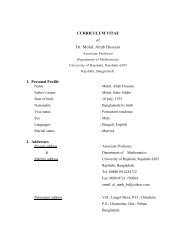University of Rajshahi Faculty of Engineering Department of Applied ...
University of Rajshahi Faculty of Engineering Department of Applied ...
University of Rajshahi Faculty of Engineering Department of Applied ...
Create successful ePaper yourself
Turn your PDF publications into a flip-book with our unique Google optimized e-Paper software.
<strong>University</strong> <strong>of</strong> <strong>Rajshahi</strong><br />
<strong>Faculty</strong> <strong>of</strong> <strong>Engineering</strong><br />
<strong>Department</strong> <strong>of</strong> <strong>Applied</strong> Physics and Electronic <strong>Engineering</strong><br />
Syllabus for M. Sc. Course<br />
Session: 2012-2013<br />
Examination – 2013<br />
The Master <strong>of</strong> Science (M. Sc.) in <strong>Applied</strong> Physics & Electronic <strong>Engineering</strong> is<br />
divided into two Groups, namely General group (A) & Thesis group (B). The<br />
courses consist <strong>of</strong> total 1000 marks (10 units) and its duration is one year.<br />
General Group (Group A)<br />
The M.Sc. Examination in <strong>Applied</strong> Physics & Electronic <strong>Engineering</strong> for the<br />
General group (Group A) comprises <strong>of</strong> six theoretical courses each <strong>of</strong> four<br />
hours duration and each carries 100 marks (4 credits). Practical examinations<br />
shall be <strong>of</strong> 24 hours (4 days; 6 hours a day). Marks for practical examination<br />
are 140. Laboratory assessment carries 60 marks. Viva-voce examination and<br />
continuous assessment (including study tour/in-plant training) carry 100 (4<br />
credits) and 100 (4 credits) marks respectively. The courses APEE-501, APEE-<br />
502, APEE-503 and APEE-504 are compulsory. Two others from optional<br />
courses shall be taken with the prior approval <strong>of</strong> the Chairman <strong>of</strong> the<br />
<strong>Department</strong>.<br />
Thesis Group (Group B)<br />
The examination <strong>of</strong> the Thesis group (Group-B) comprises <strong>of</strong> six theoretical<br />
courses out <strong>of</strong> which four courses are compulsory (i.e. APEE-501,…,504) and<br />
two are optional courses which shall be taken with the prior approval <strong>of</strong> the<br />
Chairman on the recommendation <strong>of</strong> the thesis supervisor, each <strong>of</strong> four hours<br />
duration and each carries 100 marks (4 credits). Marks on continuous<br />
assessment including study tour/in-plant training, General Viva-voce and Vivavoce<br />
on thesis are 100, 100 and 50 (2 credit) respectively. The Dissertation<br />
carries 150 marks. Students opting for the Thesis Group must take prior<br />
permission <strong>of</strong> the Chairman <strong>of</strong> the <strong>Department</strong>.<br />
Eligibility for M.Sc Examination:<br />
In order to be eligible for taking up the M.Sc examination, a candidate must<br />
have pursued a regular course <strong>of</strong> study the attending not less than 75% <strong>of</strong> the<br />
number <strong>of</strong> classes held (Theoretical, Practical, Class<br />
assessment/Tutorial/Terminal/Home assignment) provided that the Academic<br />
Committee <strong>of</strong> the <strong>Department</strong> <strong>of</strong> special grounds and on such documentary<br />
evidence as may be necessary, may condone the cases <strong>of</strong> shortage <strong>of</strong> attendance<br />
ordinarily not below 60%. A candidate appearing at the examination under the
Syllabus for M. Sc. Course (APEE), R.U., Session : 2012-13<br />
benefit <strong>of</strong> this provision shall have to pay in addition to the examination fees,<br />
the requisite fee prescribed by the Syndicate for the purpose.<br />
A candidate, who failed to appear at the examination or fails to pass the<br />
examination, may on the approval <strong>of</strong> the relevant <strong>Department</strong> be readmitted to<br />
the following session.<br />
20% <strong>of</strong> the assessment marks shall be awarded for attendance in the class on<br />
the basis <strong>of</strong> the following table:<br />
Attendance Marks Attendance Marks Attendance Marks<br />
95-100% 20% 9095% 18% 8590% 16%<br />
8085% 14% 7580% 12% 7075% 10%<br />
6570% 8% 6065% 6%
<strong>Applied</strong> Physics and Electronic <strong>Engineering</strong><br />
Where (GP)i = grade point obtained in individual course, (CP)i = credit point<br />
for respective course, GPA = grade point average obtained, and TCP = total<br />
credit point obtained. GPA shall be rounded <strong>of</strong>f up to 2 (two) places after<br />
decimal to the advantage <strong>of</strong> the examinee. For instance, GPA=2.112 shall be<br />
rounded <strong>of</strong>f as GPA=2.12.<br />
Award <strong>of</strong> Degree, Publication and Improvement <strong>of</strong> Results:<br />
(a) Award <strong>of</strong> Degree: The degree <strong>of</strong> Master <strong>of</strong> Science shall be awarded<br />
on the basis <strong>of</strong> GPA obtained by a candidate in M.Sc. In order to<br />
qualify for the M.Sc degree a candidate must obtain within 3 (three)<br />
academic years from the date <strong>of</strong> first admission:<br />
(i) a minimum GPA <strong>of</strong> 2.50,<br />
(ii) a minimum GP <strong>of</strong> 2.00 in the Practical/ Thesis, and<br />
(iii) a minimum TCP <strong>of</strong> 36.<br />
The result shall be given in GPA with the corresponding LG (Table <strong>of</strong><br />
letter LG, GP and CP) in bracket. For example “GPA=2.67(C+)”.<br />
(b) Publication <strong>of</strong> Results: The result <strong>of</strong> a successful candidate shall be<br />
declared on the basis <strong>of</strong> GPA. The transcript in English shall show the<br />
course number, course title, credit, letter grade and grade point <strong>of</strong><br />
individual courses, GPA and the corresponding LG in brackets.<br />
(c) Improvement <strong>of</strong> Result:<br />
(i) A candidate obtaining a GPA <strong>of</strong> less than 2.75 at the<br />
Examination shall be allowed to improve his result, only<br />
once as an irregular candidate within 3 academic years<br />
form the date <strong>of</strong> first admission.<br />
(ii) The year <strong>of</strong> examination, in the case <strong>of</strong> a result<br />
improvement, shall remain same as that <strong>of</strong> the regular<br />
examination. His/her previous grades for Practical<br />
courses, Class assessment/ Tutorial/ Thesis/ Dissertation<br />
courses shall remain valid (except the Theory and Vivavoce).<br />
If a candidate fails to improve his GPA, his<br />
previous result shall remain valid.<br />
3
Syllabus for M. Sc. Course (APEE), R.U., Session : 2012-13<br />
Compulsory Courses Unit Marks Credit<br />
APEE-501: Digital Communications 1.0 100 4<br />
APEE-502: Power Electronics & Control System 1.0 100 4<br />
APEE-503: Bio Medical & Analytical<br />
Instrumentation 1.0 100 4<br />
APEE-504: Condensed Matter Physics 1.0 100 4<br />
APEE-512: Continuous assessment 1.0 100 4<br />
APEE-513: Viva-voce (General) 1.0 100 4<br />
APEE-514: Practical (For Group-A) 2.0 200 8<br />
or,<br />
APEE-515: Thesis (For Group-B)<br />
Optional Courses (Any two <strong>of</strong> the following):<br />
APEE-505: Wireless Communication 1.0 100 4<br />
APEE-506: Environmental Geophysics 1.0 100 4<br />
APEE-507: VLSI design 1.0 100 4<br />
APEE-508: Image Processing and Pattern Recognition 1.0 100 4<br />
APEE-509: Computer Graphics & Multimedia 1.0 100 4<br />
APEE-510: Thin Film Technology & Energy Devices 1.0 100 4<br />
APEE-511: Plasma Physics and Materials Processing 1.0 100 4<br />
Total = 10 1000 40<br />
Marks Distribution <strong>of</strong> Practical APEE-514 (For Group A)<br />
(i) Laboratory assessment 60<br />
(ii) 4 (Four) Experiment (35x4) 140<br />
200<br />
Marks Distribution <strong>of</strong> each experiment will be as follow:<br />
i) Experiment 25<br />
ii) Viva-voce on Experiment 10<br />
35<br />
Mark Distribution <strong>of</strong> Thesis APEE-515 (For Group B)<br />
i) Dissertation 150<br />
ii) Viva-voce on Thesis 50<br />
200<br />
4
<strong>Applied</strong> Physics and Electric <strong>Engineering</strong><br />
APEE-501<br />
Digital Communications<br />
1.0 units 100 marks 4 credits 60 lectures<br />
(Time: 4 hrs; 5 out <strong>of</strong> 8 questions to be answered)<br />
1. Digital Communication Overview: Electronic Communications; Sources and<br />
sinks <strong>of</strong> information; ADC, Digital Communication; Radio receivers; Signal<br />
transmission, Switching and networks; Advantages <strong>of</strong> digital communication over<br />
analogue communication.<br />
2. Sampling, Multiplexing: Introduction, Pulse modulation, Sampling, Analogue<br />
pulse multiplexing, Quantised pulse amplitude modulation, Signal to quantisation<br />
noise ratio (SNqR), Pulse code modulation, Bandwidth reduction techniques.<br />
3. Baseband Transmission: Introduction, Baseband centre point detection, Error<br />
accumulation over multiple hops, Line coding, Multiplex telephony, Digital signal<br />
regeneration, Symbol timing recovery, Repeater design.<br />
4. Information Theory and Source Coding: Introduction, Information and entropy,<br />
Conditional entropy and redundancy, Information loss due to noise, Source coding,<br />
Variable length coding, Source coding examples.<br />
5. Error Control Coding: Introduction, Hamming distance and codeword weight,<br />
(n,k) Block codes, Syndrom decoding, Cyclic codes, Encoding <strong>of</strong> convolutional<br />
codes, Practical coders.<br />
6. Video transmission and storage: Introduction, Color representation, Conventional<br />
TV transmission systems, High definition TV, Digital video, Video data<br />
compression, Compression standards, Packet video.<br />
7. Queuing theory and its application in communication: Introduction, The arrival<br />
process, the simple server queue, Packet speech transmission.<br />
8. System noise and communications link budgets: Introduction, Physical aspects<br />
<strong>of</strong> noise, System noise calculations, Radio communication link budgets.<br />
Books Recommended:<br />
Text Books:<br />
1. Digital Communications – Ian Glover, Peter Grant, Prentice-Hall Inc.<br />
2. Computer Networking : J.F. Kuross & K. W. Ross<br />
3. Data & Computer Communication : William Stallings<br />
4. Computer Networks : Andrew S. Tanenbaum<br />
5
Syllabus for M. Sc. Course (APEE), R.U., Session : 2012-13<br />
APEE-502<br />
Power Electronics and Control System<br />
1.0 units 100 marks 4 credits 60 lectures<br />
(Time: 4 hrs; 5 out <strong>of</strong> 8 questions to be answered)<br />
1. Power Semiconductor Diode, Reverse Recovery Characteristics: Power diode<br />
types, effects <strong>of</strong> forward and reverse recovery time, series and parallel connected<br />
diode, Multiphase star rectifier, Three-phase bridge rectifier, Three-phase bridge<br />
rectifier with RL load, Effects <strong>of</strong> source and load inductance.<br />
2. Thyristor and Controlled Rectifiers: Thyristor types, series and parallel<br />
operation <strong>of</strong> thyristors, Programmable Unijunction Transistor, Principle <strong>of</strong> phasecontrolled<br />
converter operation, single phase semiconverters, single phase full<br />
converters, single phase dual converter, Three phase half-wave converter, three<br />
phase semiconverter, three phase full and dual converters, power factor<br />
improvement. Thyristor commutation technique, natural commutation, forced<br />
commutation.<br />
3. AC voltage Controllers: principle <strong>of</strong> <strong>of</strong>f-on control, principle <strong>of</strong> phase control,<br />
single-phase bi-directional converter with resistive load, three –phase half wave<br />
and full wave controller, three phase bi-directional Delta connected controllers,<br />
cycloconverters, AC voltage controllers with PWM control.<br />
4. Power Transistor: Bipolar junction transistor, MOSFETs, SITs, IGFETs<br />
(switching characteristics and switching limits), series and parallel operation.<br />
5. DC chopper: principle <strong>of</strong> step-down operation, step-down chopper with RL load,<br />
chopper classification, switching-mode regulators, Thyristor chopper circuit,<br />
Applications.<br />
6. Pulse width-modulated inverters and resonant pulse inverters: Principle <strong>of</strong><br />
operation <strong>of</strong> pulse width inverters, three phase bridge inverters, voltage control <strong>of</strong><br />
single and three phase inverters, series and parallel resonant inverters, class E<br />
resonant inverter<br />
7. DC and AC drives: Basic characteristics <strong>of</strong> DC motors, operating models, single<br />
phase drives, three phase drives, chopper drives, induction motor drives,<br />
synchronous motor drives, Applications.<br />
8. Protection <strong>of</strong> devices and circuits: Cooling and heat sinks, snubber circuits,<br />
reverse recovery transients, supply and load side transient, voltage protection by<br />
selenium diode and metal oxide varistors, current protection.<br />
Books recommended:<br />
Text Books:<br />
1. Power Electronics : M. H. Rashid<br />
2. Power Electronics : Mohan/Undeland/Robbins<br />
3. Power Electronics : P. C. Sen<br />
6
<strong>Applied</strong> Physics and Electric <strong>Engineering</strong><br />
APEE-503<br />
Bio Medical and Analytical Instrumentation<br />
1.0 units 100 marks 4 credits 60 lectures<br />
(Time: 4 hrs; 5 out <strong>of</strong> 8 questions to be answered)<br />
1. Physics <strong>of</strong> Human Body: The cell, Body fluid, Musculo-skeletal system,<br />
Respiratory system, Nervous system, The circulatory system, The body as a control<br />
system, The heart, Bioelectricity, Work done by heart, Blood pressure and its<br />
measurements, Membrane potentials, Electrical activity <strong>of</strong> excitable cells,<br />
Molecular basis <strong>of</strong> muscle contraction, Basic electrical signals from the muscles.<br />
2. Interaction <strong>of</strong> Wave and Radiation with Human Body: Body’s detector and<br />
matter wave, Speech noise, Physiological effects <strong>of</strong> intense matter waves,<br />
Interaction <strong>of</strong> electromagnetic radiation on living mater, Penetration <strong>of</strong> ray’s into<br />
tissue. Biological effects <strong>of</strong> ionizing radiation: Dosimetry, Primary effects,<br />
Biophysical effects <strong>of</strong> whole body irradiation,Rradiation measurement and<br />
protection.<br />
3. Biopotentials Electrodes and Amplifiers: Biopotential electrode, Sensors,<br />
Transducers and bioelectric amplifiers, Electromagnetic interference <strong>of</strong> medical<br />
electronic equipment, ENG, EMG, ECG, ERG, EEG, MEG.<br />
4. Ultrasonography: Physics <strong>of</strong> ultrasonic wave, Ultrasonic transducers, Absorption<br />
and attenuation <strong>of</strong> ultrasound, Scan modes, scan pattern and scanning systems,<br />
Doppler imaging, Echocardiography, Ultrasonic flow meter, Ultrasonic blood<br />
pressure measurement.<br />
5. X-ray: X-ray production, X-ray image formation and contrast, Contrast types,<br />
Effects <strong>of</strong> photon energy, Area contrast, Fluoroscopic imaging system, computed<br />
tomography.<br />
6. Magnetic resonance imaging: Nuclear magnetic resonance, Image characteristics,<br />
Gamma camera.<br />
7. Analytical and Medical Laboratory Instruments: Blood components,<br />
Colorimeter, spectrophotometer, Blood cell counter, pH/Blood gas analyzer,<br />
chromatograph, Auto analyzer, Atomic absorption and atomic emission<br />
spectroscopy.<br />
8. Therapeutic and Prosthetic Devices: Cardiac pacemaker, Hemodilysis,<br />
Defibrillator, Surgical diathermy.<br />
Books recommended:<br />
Text Books:<br />
1. Biophysics Concepts and Mechanisms : C. J. Casey<br />
2. Introduction to Biomedical equipment : Joseph J Carr & John M Brown<br />
technology<br />
3. Medical Instrumentation : John G Webster<br />
4. Medical Physics : J. G. Sk<strong>of</strong>ronick<br />
5. Physical Principles <strong>of</strong> Medical Imaging : Sprawls<br />
7
8<br />
Syllabus for M. Sc. Course (APEE), R.U., Session : 2012-13<br />
APEE-504<br />
Condensed Matter Physics<br />
1.0 units 100 marks 4 credits 60 lectures<br />
(Time: 4 hrs; 5 out <strong>of</strong> 8 questions to be answered)<br />
1. Fermi Surface & Metals: Reduced zone Scheme, Periodic Zone Scheme,<br />
Construction <strong>of</strong> Fermi surface; Calculation <strong>of</strong> Energy bands, Deep Level Transient<br />
spectroscopy (DLTS), De Haas-Van Alphen effect, Nearly free electron<br />
approximation, Tight binding method, Wigner-Seitz method. Pseudo potential<br />
method.<br />
2. Plasmons, Polaritons and Polarons: Plasma optics, plasmons, Electrostatic<br />
Screening Mott. Metal Insulator transition, Polaritons, Fermi liquid, Polarons.<br />
3. Magnetic Resonance: Nuclear Magnetic resonance, Line width Hyperfine<br />
Splitting; Nuclear quadruple resonance; Electron paramagnetic resonance,<br />
Ferromagnetic resonance; Antiferromagnetic resonance.<br />
4. Ferroelectrics: General Properties <strong>of</strong> ferroeletric materials, classification and<br />
properties <strong>of</strong> representative ferroelectrics, Dipole Theory <strong>of</strong> ferroelectricity, Ionic<br />
displacement and the behaviour <strong>of</strong> Perovskite above the Curie temperature, Theory<br />
<strong>of</strong> Spontenous polarization <strong>of</strong> Perovskite, Thermodynamics <strong>of</strong> Ferroelectric<br />
transition, Ferroelectric Domains.<br />
5. Spin Electronics: Introduction, Technical basis <strong>of</strong> spin electronics, Spin injection,<br />
Giant magneto resistance (GMR), Tunneling magneto resistance (TMR), Spintronic<br />
devices and applications: Spin transistor.<br />
6. Nanomaterials and Nanostructures: Nanoscale fabrication: Introduction to<br />
nanolithography, Self assembly and self organization, Carbon nanotubes, Quantum<br />
dot, Quantum confinement, Nanocomposites.<br />
7. Nanodevices and Nanostructure Imaging: Molecular devices, I-V characteristics<br />
<strong>of</strong> molecular devices, Molecular switch and transistor, Nanostructure <strong>of</strong> quantum<br />
computation, Imaging techniques in nanostructure: Optical microscopy, Scanning<br />
probe Microscopy, AFM, SEM, STM, TEM.<br />
8. High Tc Superconductivity: Introduction, High-Tc superconducting oxides<br />
(YBCO, LSCO), Perovskites, Normal state <strong>of</strong> high-Tc oxides, Superconducting<br />
state, Microscopic theory <strong>of</strong> high-Tc superconductivity<br />
Books recommended:<br />
Text Books:<br />
1. Introduction to Solid State Physics : Charles Kittel<br />
2. Introduction to Nanoscale Science<br />
: Massimiliano Di Ventra<br />
and Technology<br />
3. Handbook <strong>of</strong> Nanoscience, <strong>Engineering</strong>, : William A. Goddard et al.<br />
and Technology<br />
4. Introduction to Superconductivity<br />
: Michel Cyrot and Davor Pavuna<br />
and High-Tc Materials
<strong>Applied</strong> Physics and Electric <strong>Engineering</strong><br />
References Books:<br />
1. Solid State Physics : A.J. Dekker<br />
2. Electronic Process <strong>of</strong> in Materials : L Azar<strong>of</strong>f and J. Brophy<br />
3. Fundamental <strong>of</strong> Solid State<br />
Physics<br />
: B.S. Saxena, R.C. Gupta &<br />
P.N. Saxena<br />
4. Material Science for Engineers : L. H. Van Vlack<br />
5. Materials Science : J.L. Anderson, R.D. Leaver,<br />
J. H. Alexander & R.D. Rawlings<br />
APEE-505<br />
Wireless Communication<br />
1.0 units 100 marks 4 credits 60 lectures<br />
(Time: 4 hrs; 5 out <strong>of</strong> 8 questions to be answered)<br />
1. Wireless Communication system: Second generation cellular network, 2.5G<br />
wireless networks and 2.5G TDMA standards, Third & Fourth generation wireless<br />
networks, CDMA 2000, WCDMA, GSM, WiMAX, WiFi. Wireless local loop and<br />
LMDS.<br />
2. Cellular Concept-system design fundamentals: Introduction, frequency reuse;<br />
Channel Assignment and hand<strong>of</strong>f strategies, Interference and system capacity;<br />
Improving coverage & capacity in cellular system.<br />
3. Large Scale radio propagation (path loss): Free space propagation model, Radio<br />
propagation mechanisms (reflection, diffraction & scattering), Practical link budget<br />
design using path loss models, Outdoor and indoor propagation models.<br />
4. Small–scale radio propagation (fading and multipath): Small-scale multipath<br />
propagation, Small-scale multipath measurements, Parameters <strong>of</strong> mobile path<br />
channels, Types <strong>of</strong> small-scale fading, Rayleigh and Ricean distribution,. Statistical<br />
models for multipath fading channels.<br />
5. Modulation techniques for wireless radio: Digital modulation, line coding, Pulse<br />
shaping techniques, Linear modulation techniques (BPSK, DPSK) and different<br />
types <strong>of</strong> QPSK, QPSK transmission and detection techniques, Constant envelop<br />
modulation (BFSK, MSK, & GMSK), Combined linear and constant envelop<br />
modulation technique, Spread spectrum modulation techniques.<br />
6. Equalization, Diversity & Channel coding: Fundamentals <strong>of</strong> equalization,<br />
Equalization in communication receiver, Algorithm for adaptive equalization,<br />
Diversity technique, Channel coding, RAKE receiver, Block codes, Convolution<br />
codes,<br />
7. Speech coding: Characteristic <strong>of</strong> speech signals, Quantization techniques,<br />
Frequency domain coding <strong>of</strong> speech, Vocoders, Linear predictive coders.<br />
8. Multiple access techniques for wireless Communication: Introduction to<br />
multiple access, Frequency and time division multiple access, Spread spectrum<br />
multiple access, Space division multiple access, Packet radio, Capacity <strong>of</strong> cellular<br />
system, Wireless systems and standards. BTS installation & testing.<br />
9
Syllabus for M. Sc. Course (APEE), R.U., Session : 2012-13<br />
Books Recommended:<br />
Text Books:<br />
Wireless Communications : Theodore S. Rappaport,<br />
Reference Books:<br />
1. Principles <strong>of</strong> wireless networks : Kaveh Pahlavan & Prasant Krishnamurty<br />
2. Wireless Communication : Andrea Goldsmith<br />
APEE-506<br />
Environmental Geophysics<br />
1.0 units 100 marks 4 credits 60 lectures<br />
(Time: 4 hrs; 5 out <strong>of</strong> 8 questions to be answered)<br />
1. Introduction: The environment, physics in the environment, environmental systems<br />
overview, human and global environment, environmental modeling, mass balances,<br />
model calibration and verification.<br />
2. Water: Sources <strong>of</strong> water, hydrologic cycle and processes, distribution <strong>of</strong> subsurface<br />
water, flow <strong>of</strong> surface and groundwater, saturated and unsaturated flow, differential<br />
equations governing groundwater flow, water quality, sources and effects <strong>of</strong> water<br />
pollution, water treatment process and purification, natural and engineering system.<br />
3. Atmosphere: Distribution and composition <strong>of</strong> atmosphere, physical and chemical<br />
fundamental <strong>of</strong> air, origin and fate <strong>of</strong> air pollutants, effects <strong>of</strong> air pollution in micro and<br />
macro levels, greenhouse effects, effects <strong>of</strong> air pollution on meteorological conditions,<br />
solar spectrum, the Einstein coefficient, Lambert Beer’s law, solar UV and life, ozone<br />
filter, effects <strong>of</strong> thermal pollution and its prevention.<br />
4. Noise: Basic acoustics, the wave equation, intensity and levels, human perceptions<br />
and noise criteria, effects <strong>of</strong> noise pollution, rating systems, active controls <strong>of</strong> noise<br />
pollution.<br />
5. Radiation: Radioactivity and radiation, Biological effects <strong>of</strong> ionizing radiation, shortterm<br />
and long-term and genetic effects, Radiation sources in the environment, reduction<br />
<strong>of</strong> internal and external radiation hazards, low-level and high-level radioactive waste<br />
management.<br />
6. Remote Sensing: Remote sensing system, remote sensing satellites, interaction with<br />
earth, atmospheric effects, sensors, scanners, image rectification, enhancement and<br />
classification, photo-interpretation, microwave remote sensing.<br />
7. Application <strong>of</strong> Remote Sensing in Geosciences: Measurement <strong>of</strong> image features,<br />
remote sensing for survey and mapping, lithological discrimination, ocean resources,<br />
monitoring land use, studies soil and agriculture, environmental applications, sustainable<br />
development, geophysical exploration, airborne geophysical survey, DEM.<br />
8. Geographic Information System (GIS): Basic concept, components <strong>of</strong> GIS,<br />
geographic data and structure, vector and raster approaches, spatial analysis operations,<br />
spatial analysis <strong>of</strong> discrete entities and continuous fields, GIS integration techniques,<br />
errors and its propagation, Application <strong>of</strong> GIS in environmental monitoring and impact<br />
analysis, hydrogeological studies and geophysical exploration.<br />
10
Books Recommended:<br />
Text Books:<br />
1. Introduction to Environmental<br />
<strong>Engineering</strong><br />
2. Fundamental <strong>of</strong> Remote<br />
Sensing<br />
3. Concepts and Techniques <strong>of</strong><br />
Geographic Information<br />
Systems<br />
<strong>Applied</strong> Physics and Electric <strong>Engineering</strong><br />
: M.L Davis and D.A. Cornwell<br />
: Remote Sensing Tutorial, Canada<br />
Centre for Remote Sensing<br />
: C.P.L. and Albert K.W. Yeung<br />
Reference Books :<br />
1. Environmental Physics : E. Boeker and R.V.Grondelle<br />
2. Environmental Modeling : J.L. Sehnoor<br />
3. Air Pollution : M.N. Rao and H.V.N. Rao<br />
4. Fundamentals <strong>of</strong> Remote : George Joseph.<br />
Sensing<br />
5. Principles <strong>of</strong> Geographic<br />
Information Systems<br />
: P.A. Burrough<br />
APEE-507<br />
VLSI Design<br />
1.0 units 100 marks 4 credits 60 lectures<br />
(Time: 4hrs; 5 out <strong>of</strong> 8 questions to be answered)<br />
1. Digital Systems and VLSI: Design integrated circuits. Integrated circuit<br />
Manufacturing. CMOS technology. Integrated circuit Design techniques. A look into the<br />
future.<br />
2. Transistors and Layout.: Fabrication processes. Transistors. Wires and Vias.<br />
Design rules. Layout design and tools.<br />
3. Logic Gates: Combinational logic functions, Static complementary gates, Wires and<br />
delay, Switch logic, Alternative gate circuits.<br />
4. Combinational Logic Networks: Layout design methods. Simulation.<br />
Combinational network delay. Crosstalk, Power optimization. Switch logic networks.<br />
Combinational logic testing.<br />
5. Sequential Machines: Latches and Flip-Flops. Sequential systems and clocking<br />
disciplines. Sequential system design. Power optimization. Design validation. Sequential<br />
testing.<br />
6. Subsystem Design: Subsystem design principles. Combinational shifters. Adders.<br />
ALUs. Multipliers. High-density memory. Field-Programmable Gate Arrays.<br />
Programmable Logic Arrays.<br />
11
Syllabus for M. Sc. Course (APEE), R.U., Session : 2012-13<br />
7. Floor planning: Floor planning methods. Floor planning large chips. Off-chip<br />
connections.<br />
8. Architecture Design: Hardware Description Languages. Register-Transfer design.<br />
High-level synthesis. Architecture for low power. Architecture testing.<br />
Books Recommended:<br />
Text Book:<br />
1. Modern VLSI Design - Systems on Chip : Wayne Wolf<br />
Reference Book:<br />
2. Principles <strong>of</strong> CMOS VLSI Design : Weste & Eshraghian<br />
12<br />
APEE-508<br />
Image Processing and Pattern Recognition<br />
1.0 units 100 marks 4 credits 60 lectures<br />
(Time: 4 hrs; 5 out <strong>of</strong> 8 questions to be answered)<br />
1. Introduction: Digital image, Steps in digital image processing, Components <strong>of</strong> an<br />
image processing system, Application <strong>of</strong> digital image processing, Image sampling<br />
and quantization, Basic relationships between pixels.<br />
2. Intensity Transformations and Spatial Filtering: Basic concepts, Intensity<br />
transformation functions, Histogram processing, Mechanics <strong>of</strong> spatial filtering,<br />
spatial correlation and convolution.<br />
3. Filtering in the Frequency Domain: Preliminary concepts, Extension to functions<br />
<strong>of</strong> two variables, Properties <strong>of</strong> 2-D DFT, Discrete cosine transform, Filtering<br />
fundamentals, Steps for filtering Image smoothing, Image sharpening, Image<br />
restoration, Noise models, Noise reduction, Inverse filtering, Wiener filter.<br />
4. Wavelets and Multiresolution Processing: Background, Haar transform,<br />
Multiresolution expansions, Wavelet transforms.<br />
5. Image compression: Fundamentals <strong>of</strong> image compression, Coding redundancy,<br />
Spatial and temporal redundancy, image compression model, Huffman coding.<br />
6. Morphological Image Processing: Erosion, Dilation, Opening, Closing, Basic<br />
morphological algorithms-Boundary extraction, Hole filling, Skeletons.<br />
7. Image Segmentation and Color Image Processing: Basic concepts, Point, linc,<br />
and edge detection, Thresholding, Region-based segmentation, Color models,<br />
Color transformations.<br />
8. Pattern Recognition: Patterns and pattern classes, Recognition based on decisiontheoretic<br />
methods, Basic model <strong>of</strong> a neuron, Perceptron, Neural networks, Learning<br />
methods.
<strong>Applied</strong> Physics and Electric <strong>Engineering</strong><br />
Books Recommended:<br />
Text Book:<br />
1. Digital Image Processing : Rafael C. Gonzalez, Richard E. Woods<br />
Reference Books:<br />
1. Image Processing, Analysis and Machine Vision : Millan Sonka, Vaclau<br />
Hlavac, Roger Boyle.<br />
2. Digital Image Processing : William K. Pratt<br />
APEE-509<br />
Computer Graphics and Multimedia<br />
1.0 units 100 marks 4 credits 60 lectures<br />
(Time: 4 hrs; 5 out <strong>of</strong> 8 questions to be answered)<br />
1. Introduction & Graphic Devices: Brief history, Graphics input devices, Graphics<br />
storage devices, Communication devices, Common display devices, Raster-Scan<br />
CRT.<br />
2. Graphics Fundamentals and Scan Conversion: Hardware and s<strong>of</strong>tware and the<br />
fundamental ideas behind modern computer graphics, Scan converting a point, a<br />
straight line, a circle.<br />
3. 2-Dimensional & 3-Dimensional Graphics Transformation And Creation:<br />
Geometric transformation; Coordinate transformation; Composite transformation;<br />
Two dimensional viewing transformation, Three dimensional viewing<br />
transformation; Applications as Adobe PhotoShop, Paintbrush etc.<br />
4. Geometric Forms, Models and Hidden Surfaces: Introduction, Simple geometric<br />
forms, Weinframe models, Curved surfaces, Curve design, Depth comparisons, Z-<br />
Buffer algorithm, Scan line algorithms.<br />
5. Multimedia Media and Data Streams: The perception Medium, The<br />
representation medium, Presentation medium, Storage medium, Combination<br />
Media, Multimedia, Asynchronous and synchronous transmission mode, The time<br />
interval between a complete transmission <strong>of</strong> consecutive packets.<br />
6. Sound: Computer representation <strong>of</strong> sound, Auto formats, MIDI Basic concepts,<br />
MIDI devices, MIDI s<strong>of</strong>tware, Speech generation.<br />
7. Images, Graphics, Video and Animation: Digital image representation, image<br />
format, graphics format, image synthesis, Video signal representation, Computer<br />
video format, Animation Language, Display <strong>of</strong> Animation.<br />
8. Data Compression and Optical Storage Media: Storage space, Coding<br />
requirements, Basic compression techniques, JPEG, MPEG, Video disks and other<br />
WORMs, Compact disk digital audio, CD-ROM Extended architecture, CD-ROM<br />
based developments.<br />
13
Syllabus for M. Sc. Course (APEE), R.U., Session : 2012-13<br />
Books Recommended:<br />
Text Books:<br />
1. Computer Graphics :Roy A. Plastock Gordon Kalley<br />
2. Multimedia: computing, communications & Applications :Ralf Steinmetz and<br />
Klara Nahrstedt<br />
14<br />
APEE-510<br />
Thin Film Technology & Energy Devices<br />
1.0 units 100 marks 4 credits 60 lectures<br />
(Time: 4 hrs; 5 out <strong>of</strong> 8 questions to be answered)<br />
1. Thin Film Preparation Techniques: Thermal evaporation, Evaporation theory<br />
and mechanism, E-beam evaporation, Sputtering, Plasma and Ion bean<br />
Sputtering, Sputtering yields, MBE, Chemical Vapor Deposition, Spray<br />
pyrolysis, Sol-gel technique.<br />
2. Growth and Structure <strong>of</strong> Thin Films: Thermodynamics <strong>of</strong> Nucleation,<br />
Atomistic Theory <strong>of</strong> Nucleation, Coalescence, Influence <strong>of</strong> deposition<br />
parameters, Crystallographic structure <strong>of</strong> Thin Films, Epitaxial-growth<br />
phenomena, Structural defects in Thin Films.<br />
3. Thickness measurements & Analytical Techniques: Electrical methods;<br />
Mechanical methods; Optical interference method; Analytical techniques,<br />
Chemical analysis, Structural analysis, Surface structure optical methods; Low<br />
energy electron interaction (LEEI) Auger electron spectroscopy, X-ray<br />
diffraction, Transmission Electron microscopy and Scanning Electron<br />
Microscopy.<br />
4. Transport Phenomena in Metal and Semiconducting Films: Electrical<br />
conduction in discontinuous & continuous films. Temperature effect, Field<br />
effect, Hall effect, Thermoelectric power, Quantum size effect, Activation<br />
process, Optical absorption, transmission, reflection, Photoconductive<br />
mechanisms.<br />
5. Transport Phenomena in Insulating Films: Electrical conduction in insulating<br />
films, Inhomogenous materials, Cermet, Electrical conduction, Effective<br />
medium theories, Maxwell-granett theory, Bruggman theory, Field effect,<br />
modified effects, Schottky effect, Poole-Frenkel effect, Tunneling & space<br />
charge limited Conduction.<br />
6. Energy Efficiency: Selective surface coating, Thermochromism,<br />
electrochromosim, photochromosim, Smart window , Materials for smart<br />
Window, Energy efficient devices.
<strong>Applied</strong> Physics and Electric <strong>Engineering</strong><br />
7. Photovoltaic System & Modules: a-Si materials, Optimization <strong>of</strong> cell<br />
parameters, Heterojunction cells, Module efficiency measurements, Module<br />
control test specification, photoelectrochemical cells based on different<br />
semiconducting materials, Hydrogen based Fuel cells, New materials for<br />
hydrogen production.<br />
8. CVD and Spary Pyrolysis material: CVD Technique and measurements,<br />
materials for CVD, spray Pyrolysis Technique and measurements, materials for<br />
Spray Pyrolysis Sol-gel Techniques & material search.<br />
Books Recommended:<br />
Text Books:<br />
1. Thin Film Phenomena :K.L. Chopra<br />
2. Hand Book <strong>of</strong> Thin Films Technology : Maissel and Glang<br />
3. Thin Film Technology :C.G,Gavanqirst and G.A Niklassons<br />
4. Solar Energy Conversion :A.E. Dixon and J.D. Leslie<br />
Reference Books:<br />
1. Thin Film Device, Applications :K.L.Chopra and I. Kaur<br />
2. Thin Film Physics :O.S. Heavens<br />
3. Solar Power <strong>Engineering</strong> :B.S. magal<br />
4. Solar Selective Surface :O.P. Agnihotri and B.K. Gupta<br />
5. Solar <strong>Engineering</strong> <strong>of</strong> Thermal Process :J.A. Duffie, and W.A. Beckman<br />
APEE-511<br />
Plasma Physics and Materials Processing<br />
1.0 units 100 marks 4 credits 60 lectures<br />
(Time: 4 hrs; 5 out <strong>of</strong> 8 questions to be answered)<br />
1. Basic Plasma Equations And Equilibrium: Field Equations, Maxwell’s<br />
Equations, The Conservation Equations, Boltzman’s Equations, Macroscopic<br />
quantities, Particle Conservation, Momentum Conservation, Energy Conservation,<br />
Equilibrium Properties, Boltzman’s relation, Debye Length, Quasineutrality.<br />
2. Collision Processes: Basic concepts, Elastic and Inelastic Collisions, Collision<br />
Parameters, Differential Scattering Cross Section, Collision Dynamics, Energy<br />
Transfer, Small-Angle Scattering, Elastic Scattering, Polarization Scattering,<br />
Inelastic Collisions, Electric Dipole Radiation and Metastable Atoms, Cross<br />
Sections, Maxwellian Distribution, Surface Effects, Molecular collisions.<br />
3. Plasma Dynamics: Basic Motions, Nonmagnetized Plasma Dynamics, Guiding<br />
Center Motion, Dynamics <strong>of</strong> Magnetized Plasmas, Waves in Magnetized Plasmas,<br />
Wave Diagnostics.<br />
15
Syllabus for M. Sc. Course (APEE), R.U., Session : 2012-13<br />
4. Diffusion and Transport: Basic relations, Diffusion Solutions, Low-Pressure<br />
Solutions, Diffusion across a Magnetic Field, Magnetic Multipole Confinement.<br />
5. Dc Sheaths: Basic Concepts and Equations, Bohm Sheath Criterion, High-voltage<br />
Sheath, Criteria for Sheath Formation, Collisional Sheaths, Probe Diagnostics.<br />
6. Chemical Reactions and Equilibrium: Energy and Enthalpy, Entropy and Gibbs<br />
Free Energy, Chemical Equilibrium, Heterogeneous Equilibrium.<br />
7. Chemical Kinetics and Surface Processes: Elementary Reactions, Gas-Phase<br />
Kinetics, Surface Processes, Surface Kinetics.<br />
8. Different Types <strong>of</strong> Discharges: Capacitive Discharges, Inductive Discharges,<br />
Wave-Heated Discharges, DC Discharges, Etching, Plasma-Enhanced chemical<br />
Vapor Deposition, Sputter Deposition, Plasma Immersion Ion Implantation.<br />
Books Recommended:<br />
Text Books:<br />
1. Principles <strong>of</strong> Plasma Discharges and Materials Processing: Michael A. Lieberman and<br />
Allan J. Lichtenberg<br />
Reference Books:<br />
1. Gas Discharge Physics: Yuri P. Raizer.<br />
16



